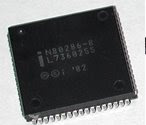RAM (random access memory) is the place in a computer where the operating system, application programs, and data in current use are kept so that they can be quickly reached by the computer's processor. RAM is much faster to read from and write to than the other kinds of storage in a computer, the hard disk, floppy disk, and CD-ROM. However, the data in RAM stays there only as long as your computer is running. When you turn the computer off, RAM loses its data. When you turn your computer on again, your operating system and other files are once again loaded into RAM, usually from your hard disk.
RAM can be compared to a person's short-term memory and the hard disk to the long-term memory. The short-term memory focuses on work at hand, but can only keep so many facts in view at one time. If short-term memory fills up, your brain sometimes is able to refresh it from facts stored in long-term memory. A computer also works this way. If RAM fills up, the processor needs to continually go to the hard disk to overlay old data in RAM with new, slowing down the computer's operation. Unlike the hard disk which can become completely full of data so that it won't accept any more, RAM never runs out of memory. It keeps operating, but much more slowly than you may want it to.
Monday, February 23, 2009
Friday, February 13, 2009
Intel 8080
The Intel 8080 was an early microprocessor designed and manufactured by Intel. The 8-bit CPU was released in April 1974 running at 2 MHz (at up to 500,000 instructions per second), and is generally considered to be the first truly usable microprocessor CPU design. It was implemented using non-saturated enhancement-load NMOS, demanding extra voltages.
The Intel 8080 was the successor to the Intel 8008. It used the same instruction set as the 8008 (developed by Computer Terminal Corporation) and was source code compatible. The 8080's large 40 pin DIP packaging permitted it to provide a 16-bit address bus and an 8-bit data bus, allowing easy access to 64 kilobytes of memory.
As the chip was delayed and did not meet CTC's performance goals, the 2200 ended up using CTC's own TTL based CPU instead. An agreement permitted Intel to market the chip to other customers after Seiko expressed an interest in using it for a calculator.
The Intel 8080 was the successor to the Intel 8008. It used the same instruction set as the 8008 (developed by Computer Terminal Corporation) and was source code compatible. The 8080's large 40 pin DIP packaging permitted it to provide a 16-bit address bus and an 8-bit data bus, allowing easy access to 64 kilobytes of memory.
As the chip was delayed and did not meet CTC's performance goals, the 2200 ended up using CTC's own TTL based CPU instead. An agreement permitted Intel to market the chip to other customers after Seiko expressed an interest in using it for a calculator.
Monday, February 09, 2009
Pioneer 10
Pioneer 10 (also called Pioneer-F) was the first spacecraft to travel through the asteroid belt, which it entered on July 15, 1972, and to make direct observations of Jupiter, which it passed by on December 3, 1973. It was launched from Cape Canaveral Air Force Station's Launch Complex 36A on March 2, 1972. Pioneer 10 is heading in the direction of Aldebaran, located in Taurus. By some definitions, Pioneer 10 has become the first artificial object to leave the solar system. It is surely the first human-built object to have been set upon a trajectory leading out of the solar system. However, it still has not passed the heliopause or Oort cloud.
Its objectives were to study the interplanetary and planetary magnetic fields; solar wind parameters; cosmic rays; transition region of the heliosphere; neutral hydrogen abundance; distribution, size, mass, flux, and velocity of dust particles; Jovian aurorae; Jovian radio waves; atmosphere of Jupiter and some of its satellites, particularly Io; and to photograph Jupiter and its satellites.
Its objectives were to study the interplanetary and planetary magnetic fields; solar wind parameters; cosmic rays; transition region of the heliosphere; neutral hydrogen abundance; distribution, size, mass, flux, and velocity of dust particles; Jovian aurorae; Jovian radio waves; atmosphere of Jupiter and some of its satellites, particularly Io; and to photograph Jupiter and its satellites.
Monday, February 02, 2009
Intel 4004
The Intel 4004 is a 4-bit central processing unit (CPU) released by Intel Corporation in 1971. The 4004 is the first complete CPU on one chip, the first commercially available microprocessor, a feat made possible by the use of the new silicon gate technology allowing the integration of a higher number of transistors and a faster speed than was possible before. The 4004 employed a 10 μm silicon-gate enhancement load pMOS technology and could execute approximately 92,000 instructions per second (that is, a single instruction cycle was 11 microseconds).
The 4004 was released on November 15, 1971. Packaged in a 16-pin ceramic dual in-line package, the 4004 is the first computer processor designed and manufactured by chip maker Intel, which previously made semiconductor memory chips. The chief designers of the chip were Federico Faggin and Ted Hoff of Intel, and Masatoshi Shima of Busicom (later of ZiLOG, founded by Federico Faggin).
The 4004 was released on November 15, 1971. Packaged in a 16-pin ceramic dual in-line package, the 4004 is the first computer processor designed and manufactured by chip maker Intel, which previously made semiconductor memory chips. The chief designers of the chip were Federico Faggin and Ted Hoff of Intel, and Masatoshi Shima of Busicom (later of ZiLOG, founded by Federico Faggin).
Subscribe to:
Posts (Atom)




